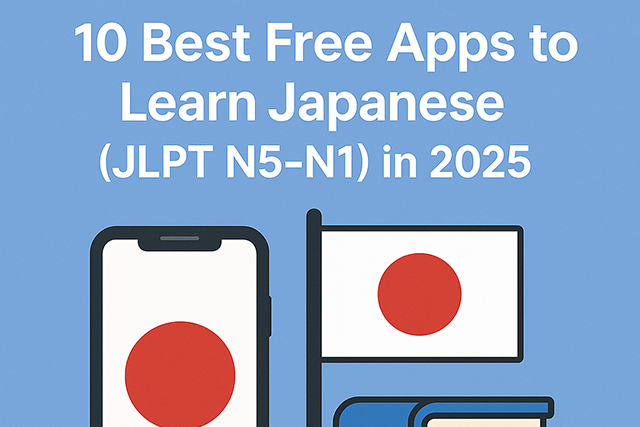10 Best Free Apps to Learn Japanese in 2025
Learning Japanese is an exciting journey, whether you’re preparing for a trip to Japan, watching anime without subtitles, or planning to pass the JLPT. Thankfully, there are plenty of free Japanese learning apps available that make it easy and fun to study anytime, anywhere.
In this blog post, we’ll explore the top 10 free apps to learn Japanese in 2025, each offering unique features to help beginners and intermediate learners improve their vocabulary, grammar, kanji, and conversation skills.
1. Duolingo – Gamified Japanese Lessons
Best for: Beginners looking for daily practice
Duolingo offers a fun, game-like approach to learning Japanese. With bite-sized lessons, you’ll build vocabulary and basic sentence structures quickly. The app also includes hiragana and katakana learning modules.
Pros:
- Easy to use
- Great for daily habits
- Includes leaderboards and rewards
- Progress tracking with streaks
Cons:
- Limited grammar explanations
- Can be repetitive for advanced learners
Available on: Android, iOS, Web
2. LingoDeer – Designed for Asian Languages
Best for: Structured grammar and sentence building
Unlike Duolingo, LingoDeer was designed specifically for Asian languages like Japanese, Korean, and Chinese. It teaches you grammar rules, particles, and kanji in a structured way.
Pros:
- Audio from native speakers
- Grammar explanations
- Offline mode
- Well-organized curriculum
Cons:
- Limited free content (premium features locked)
- Less gamification than Duolingo
Available on: Android, iOS
3. Tandem – Language Exchange with Native Speakers
Best for: Practicing speaking and listening
Tandem connects you with native Japanese speakers for language exchange. You can chat via text, audio, or video, helping you learn natural Japanese and build cultural understanding.
Pros:
- Real conversation practice
- Cultural exchange
- Corrected feedback
- Voice and video calls
Cons:
- Requires confidence to speak with strangers
- Quality varies depending on language partners
Available on: Android, iOS, Web
4. Anki – Flashcards for Kanji and Vocabulary
Best for: Memorizing vocabulary and kanji
Anki is a powerful spaced repetition system (SRS) app. You can download pre-made decks or create your own for JLPT vocabulary, kanji practice, or grammar points.
Pros:
- Highly customizable
- Efficient long-term memorization
- Sync across devices
- Large community-created deck library
Cons:
- Steep learning curve for beginners
- Interface can be overwhelming
Available on: Android, iOS, Web, Desktop
5. HelloTalk – Chat with Native Speakers
Best for: Text-based conversation practice
HelloTalk connects learners with native speakers via chat, with built-in translation and correction tools. It’s a great way to improve your casual writing and reading.
Pros:
- Community support
- Voice notes and calls
- Correction feature
- Moments feed for cultural sharing
Cons:
- Can be distracting with social media features
- Some users looking for dating rather than learning
Available on: Android, iOS
6. JapanesePod101 – Audio and Video Lessons
Best for: Listening comprehension
JapanesePod101 offers thousands of free audio and video lessons, from beginner to advanced levels. It’s great for improving listening skills and learning natural phrases.
Pros:
- Daily lessons
- Native speaker dialogues
- Downloadable transcripts
- Cultural insights
Cons:
- Best features require premium subscription
- Can be overwhelming with too many options
Available on: Android, iOS, Web
7. Takoboto – Japanese Dictionary and Learning Tool
Best for: Instant word lookup
Takoboto is a fast and simple Japanese-English dictionary app. It shows word definitions, kanji readings, example sentences, and verb conjugations.
Pros:
- Offline access
- Kanji breakdown
- Minimal and fast interface
- Detailed word information
Cons:
- Limited to dictionary functions
- Android only
Available on: Android, Windows
8. Imiwa? – Comprehensive Japanese Dictionary
Best for: iOS users needing a dictionary
Imiwa? is a powerful Japanese dictionary app for iOS. It includes example sentences, stroke order diagrams, and JLPT-level sorting.
Pros:
- No internet needed
- Great for iPhone and iPad
- Supports multiple input methods
- Stroke order animations
Cons:
- iOS exclusive
- Interface feels dated
Available on: iOS
9. Bunpo – Grammar-Focused Learning
Best for: JLPT grammar practice
Bunpo offers grammar lessons sorted by JLPT levels, from N5 to N1. Each lesson includes explanations, example sentences, and quizzes.
Pros:
- Clean UI
- Progress tracking
- In-depth grammar lessons
- JLPT-focused structure
Cons:
- Limited vocabulary practice
- Some advanced features require payment
Available on: Android, iOS
10. Learn Japanese N5~N1 (JLPT) – Comprehensive JLPT Study Companion
Best for: Structured JLPT preparation across all levels
Developed by Ikigai Technology K.K, Learn Japanese N5~N1 (JLPT) is a dedicated app that takes the stress out of preparing for the Japanese Language Proficiency Test. What makes this app special is how it breaks down each JLPT level into digestible lessons covering grammar, vocabulary, and kanji – all with clear English explanations that actually make sense.
The N5 level content comes completely free, which is perfect for beginners who want to test the waters. If you find it helpful (and you probably will), unlocking each additional level from N4 to N1 costs just $1.99 – that’s less than a cup of coffee for months of structured study material.
Pros:
- Covers every JLPT level from beginner to advanced
- English explanations that don’t leave you confused
- Super affordable upgrade pricing
- Clean interface that won’t overwhelm you
- Perfect for systematic exam preparation
Cons:
- Only N5 content is completely free
- Some example sentences could use improvement
- Focuses specifically on JLPT rather than conversational Japanese
Available on: iOS, Android
Tips for Success with Japanese Learning Apps
1. Combine Multiple Apps
Think of these apps as your Japanese learning toolkit – each one serves a different purpose. You might start your morning with Duolingo for a quick grammar boost, use Anki during your commute to memorize kanji, and chat with native speakers on HelloTalk before bed. This variety keeps things interesting and covers all your learning bases.
2. Set Realistic Goals
Here’s the truth: studying for three hours once a week won’t get you far. Instead, aim for 10-15 minutes every single day. It might not seem like much, but those small daily wins add up to major progress over time. Your brain will thank you for the consistency too.
3. Focus on Your Weak Areas
Be honest about what’s holding you back. If kanji makes you want to hide under a blanket, spend extra time with Anki or the JLPT app. If the thought of speaking Japanese makes you nervous, push yourself to use Tandem or HelloTalk more often. Growth happens outside your comfort zone.
4. Track Your Progress
Most apps show you how far you’ve come, and those progress bars aren’t just for show. Pay attention to them! They’ll help you spot patterns – maybe you’re great at vocabulary but struggle with listening comprehension. Use this insight to adjust your study routine.
5. Practice Daily
This can’t be stressed enough: five minutes every day beats a three-hour cram session once a week. Make Japanese practice as routine as brushing your teeth. Your future self will be amazed at how much you’ve learned.
Conclusion
Learning Japanese doesn’t have to feel overwhelming or expensive. These free apps prove that you can make real progress without breaking the bank or sitting in a traditional classroom. Whether you’re dreaming of your first trip to Tokyo, trying to understand your favorite anime, or preparing for the JLPT, there’s an app here that matches your goals and fits your lifestyle.
The secret isn’t finding the “perfect” app – it’s finding the ones that you’ll actually stick with. Start small with one or two that catch your interest, then gradually add others as your confidence grows. Some days you might feel like chatting with native speakers, other days you might prefer quiet kanji practice. That’s perfectly normal, and having options keeps your learning fresh.
Remember, every expert was once a beginner who refused to give up. Those Japanese characters that look impossible today will become familiar friends with consistent practice. The grammar rules that confuse you now will start clicking into place. And yes, you really will understand anime without subtitles someday.
Ready to turn your Japanese dreams into reality? Pick an app, download it right now, and take that first small step. Your future fluent self is waiting.

